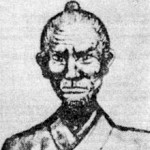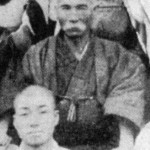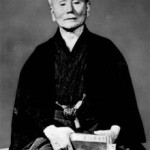Satunuku Sakugawa Kanga, aka Tode/Toudi or Karate Sakugawa (1733 – 1857 CE), was an Okinawan Karate Master in the 18th and 19th centuries who is best known as Bushi Sokon Matsumura’s teacher, and creator of the Kusanku kata that is practiced in many of the styles that sprout from this lineage. He is also known as the father of Okinawan Karate, which is a title that he shares with his great-grand student Gichen Funakoshi; although he is the lesser known of the two, all things being even.
So, why is this guy one of the notable masters? He is considered to be a major contributor to the development of Te, which would later be developed by his student from the province of Shuri, Sokon “Bushi” Matsumura, into Shuri-te Karate. His training would begin with a Ryukyu monk known as Peichin Takahara for six years, but would later train under a Chinese emissary of the Qing dynasty to the Naha region of Okinawa named Kwang Shang Fu – which was pronounced “Ku san ku” in Japanese. He would travel with his master back to China and train there for six years. After returning to Japan, Sakugawa would amalgamate and further his training, and eventually he would create the kata Kusanku (aka Kanku Dai) in honour of his second master. During this time, he would also be given the nickname “Tode” – meaning “Chinese Hand”.
While we’re on the topic, here’s a little semantic history lesson – Karate, in Japanese, is two words: Kara and Te. The modern world knows these to be translated as “Empty” and “Hand” but, pre-Gichin Funakoshi era, these words originally translated as “Chinese” and “Hand” respectively – it was Funakoshi who would later change the symbol of “Chinese” to “Empty” to help Karate be accepted as more “Japanese” during the early 20th century. Until this, “Karate” meant the fighting styles, concepts, and techniques that came over from China and were adopted/modified by the Okinawans. (So, if anyone still criticizes Jackie Chan/Jayden Smith’s remake of the “Karate Kid” based on the argument that “it’s Kung Fu, not Karate”, then they don’t know their history…)
On another note, Japan had many levels of social hierarchy, which would be reflected in titles such as Peichin (as his first instructor was), and Satunuku; these titles would become an honourific, and be associated with them as much as a name. A Peichin would be the Okinawan equivalent of the Japanese Samurai, but also having scholarly intonations included.
Tode Sakugawa would earn the title of Satunuku for his service to the Okinawan King. The title of Satunuku (aka Satonushi) was generally awarded to Samurai in service of the King, which would mean that Sakugawa was likely also a Peichin at some point in his life. Considering that Okinawa had not, as yet, been officially annexed by Japan (as would happen in the later 19th century), it was during this time that Japan was still in its “Sakoku” period (literally “Closed Country”), where it opted to be willfully blind to the outside world, including its nearby occasional ally and enemy, the Chinese. It’s during this period that the Ryukyu Islands became a sort of middle ground for trade between Japan and China, where China believed that it governed the island chain, while Japan laid claim that they were their protectors, so the Ryukyu Island chain (including the island of Okinawa) would liaise between the two major Asian players, and learn from both.
This is one of the periods of major and intense development of modern day Karate – when the Japanese Shimazu clan banned the ownership and use of swords by the laity, instead enforcing that only Samurai could have them; the consequence was that the laity began training in alternative martial training: Empty hand, and farm implement. Most Martial Artists studying in an Okinawan influenced art will have heard something akin to this story in the course of their training, where the farmers would pick up their farm implements and learned how to use things such as the sai (rice thresher), tonfa (millstone handle), bo (walking stick), and kama (harvesting blades) in self-defence uses.
The interesting thing is that there remains a heavy debate regarding the origins of these weapons, which would contradict the generally accepted history mentioned above (such as many of these weapons have cultural links to other countries, like the sai in India, and the tonfa in Thailand). This doesn’t impact Sakugawa’s influence in the development of Okinawan Kobudo – his mastery of the sai and tonfa were passed to his student, Bushi Matsumura, and three of his katas are still practices today: Chatan Yara no Sai, Yara Sho no Tonfa, and Chatan Yara no Kon.
Tode Sakugawa would go on to teach Sokon “Bushi” Matsumura, who would later instruct Anko Itosu – who would be one of the instructors to Gichen Funakoshi, the generally accepted Father of Modern Karate. While Shuri-te – the style that Bushi Matsumura would found – is still practiced, but another style that came from his development of Te was Shorin Ryu, which would later also found Shorinji Kempo.
All of this together illustrates that Tode Sakugawa’s powerful influence on the development of the Okinawan Martial Arts, and its influence on Japans as well.





